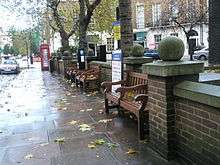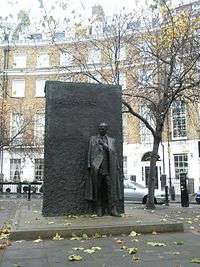Great Cumberland Place
Great Cumberland Place is a street in the City of Westminster, part of Greater London, England. There is also a hotel bearing the same name on the street.

Description
The street runs from Oxford Street at Marble Arch to George Street at Bryanston Square.[1]
It contains the Western Marble Arch Synagogue, near which stands a statue of Raoul Wallenberg.
Great Cumberland Place[2] is home to The Cumberland Hotel[3].
Notable residents

The street was the home of Thomas Pinckney while he was the United States ambassador to the Court of St James's.[4]
Sir James Mackintosh lived in Great Cumberland Street, which was later re-numbered as part of Great Cumberland Place.[5]
The residents listed in 1833 were: "Hans Busk, Esq.; Sir Clifford Constable; Sir Frederick Hamilton; Lady C. Underwood; Sir G. Ivison Tapps; Baron Bülow (the Prussian Minister); General Sir R. M'Farlane; Leonard Currie, Esq.; Sir S. B. Fludyer, Bart.; Lady Trollope; Earl of Leitrim; Sir Alexander Johnston; and the Hon. and Right Rev. the Lord Bishop of Norwich", and in Great Cumberland Street "Lord Saltoun; Mrs. Portman; John Wells, Esq.; Colonel Sherwood; Captain Richard Manby; John Lodge, Esq.; Major Murray; Robert Cutlar Fergusson, Esq.; John N. McLeod, Esq.; and Lord Bagot".[6]
The explorers James Theodore Bent and Mabel Bent lived first at Number 43 and then Number 13 Great Cumberland Place from the early 1880s until Mabel Bent's death in 1929.[7]
References
| Wikimedia Commons has media related to Great Cumberland Place. |
- Google Map
- Great Cumberland Place London "google.com".
- The Cumberland Hotel London "www.sites.google.com".
- State papers and publick documents of the United States, Volume 1 (Boston: Thomas B. Wait, 1819), p. 402
- Henry Benjamin Wheatley, Peter Cunningham, London Past and Present: Its History, Associations, and Traditions (Cambridge University Press, 2011), p. 483
- Thomas Smith, A Topographical and Historical Account of the Parish of St. Mary-le-Bone (1833), p. 223
- The Times, 28 November 1899.